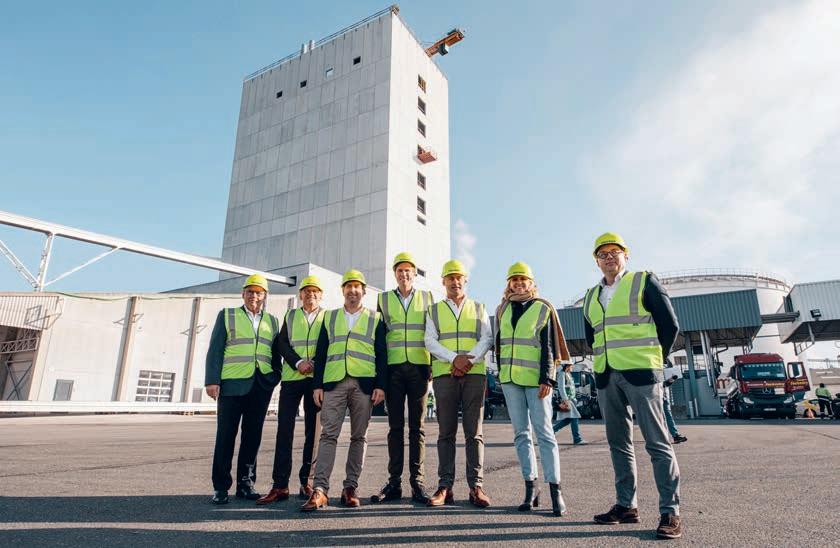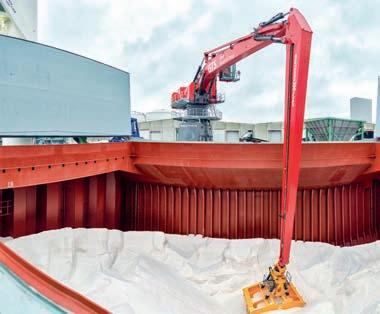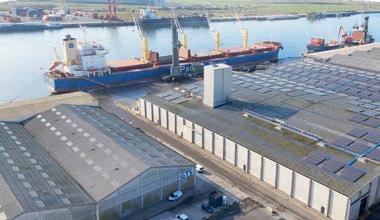
8 minute read
Zoutman A tower as new stepping stone
A tower as new stepping stone
Zoutman readies for new growth in salt business
Advertisement
When fnished, the production tower will be sided by a brand new high-rise warehouse, adding to the storage capacity of the terminal at the Kluizendok.
The biggest covered salt terminal in a European port will soon be equipped with one of the highest and most advanced salt production towers in the world. Zoutman is building the new facility at its logistical hub and production site at the Kluizendok in Ghent. It will enable the company to add 150,000t to its yearly output and to keep up with growing demand for additive-free sea salt. It will also reinforce North Sea Port’s role as a food port.
The new production tower will be operational by mid-2023 and create about forty extra jobs. The investment of EUR 30 million, the biggest for Zoutman so far, will also pave the way for a doubling of Zoutman’s turn-over by 2030. This way, Ghent will once again become a major stepping stone in the group’s development. In 2005, Zoutman was one of the very frst operators to settle at the new Kluizendok. The terminal made it possible to ensure the overseas supply of raw sea salt in large quantities that can be unloaded at the own quay of the company and stored in the adjacent warehouses that equally belong to Zoutman. Since then, Zoutman is very much master of its own logistic chain. Salt being a very price-sensitive commodity, buying at the right time and keeping logistical costs as low as possible, is vital for the company.
A growing force in the salt business
Zoutman was founded in 1990 by Bart and Peter Sobry. The company focusses on the production of sea salt products that meet the highest certifcations for the food industry (“from ultra-fne salt that can be used in spice mixes to rougher varieties like the salt covering pretzel biscuits”), water treatment, de-icing, agriculture, technical applications, and wellness. These non-chemical applications account for 40% of the worldwide salt market (estimated at 340t million last year). Zoutman has two production plants with a direct connection to the waterway, one in Roeselare, the other in North Sea Port. The deepwater maritime terminal in Ghent is the largest of its kind in Europe, offering a covered storage capacity of 300,000t. It opened in 2005. This terminal enables Zoutman to handle shipments of up to 80,000t of sea salt harvested in regions like the Caribbean or Australia. Each year, the company ships out 300,000 to 450,000t (in bags, big bags, bulk, and containers) to over 60 countries across the globe. 60% of the production is exported, with neighbouring countries and North America as main destinations. Zoutman has about hundred people on its payroll and generated a turn-over of EUR 46 million last year. The new tower in Ghent will create about forty extra jobs.
Photo courtesy of Zoutman.

Daniël Termont (former mayor of Ghent), Daan Schalck (CEO North Sea Port), Bert Lamote (co-CEO Zoutman), Mathias De Clercq (mayor of Ghent), Jan Cerpentier (CTO Zoutman), Sofe Bracke (Alderman of the Port) and Karel Vandecappelle (CFO Zoutman) in front of the new production tower under construction.
Outbound distribution and production activities – for lowerend products – soon followed. Storage capacity was lifted to 300,000t some ten years ago. The terminal also allowed for the transhipment of salt on barges headed for the main plant in Roeselare, which is also directly connected to a waterway.
Vertical expansion
“For a young family business competing with multinationals, it was a bold move, but it proved a crucial one”, co-CEO Bert Lamote recalls. Indeed, the terminal at the Kluizendok was a major factor for Zoutman to achieve an average growth rate of 10% per year in a market that expands at a far slower global pace of less than 2% annually. Zoutman is eager to stay on that track and was looking at ways to strengthen its Ghent site, which would provide the added advantage of increasing overall operational reliability and fexibility. Since added space was not readily available in the area where the company settled almost twenty years ago, the boundaries of the 7.5 hectares concession could not be pushed. So the decision was made to go vertical. The result is the 64.5m high production unit that now literally towers high above the many warehouses on the north side of the Kluizendok. The investment in Ghent comes on top of earlier expansions in Roeselare. The plant along the Roeselare-Leie canal for inland navigation underwent a thorough upgrade, requiring some EUR 18 million of capital expenditure in recent years. The production towers were expanded, a new one was built,

Five facts about the new production tower
• The tower is 64.5m high. It takes 360 stair steps to climb the ten foors of the building. • It took 7,300m³ of concrete and 1,000t of steel to build the tower, which rests on 290 foundation piles. • When fnished, the tower will be covered with 6,100m² of stainless steel plating. • It offers 8,000m² of production room on a ground surface of 1,800m². • It can store different salt grain sizes in 22 vertical silos with a total capacity of 1,700t.
Photo courtesy of Jean-Louis Vandevoorde.
For a young family business competing with multinationals, building the largest salt terminal in Europe was a bold move, but it proved a crucial one.
production processes were optimised and automated, water consumption was reduced to a minimum by purifying and reusing process water, sixteen storage silos and two packaging units were added, again to meet growing demand for highquality salt. Finally, a new, larger offce building now houses the headquarters of the company.

Growing hunger for sea salt
The new tower in Ghent will focus on the production of highgrade sea salt without additives, allowing Zoutman to bring larger volumes to the market. Demand for sea salt in general and for additive-free sea salt in particular is booming, especially in the food industry, says Mr Lamote. “Traditional kitchen salt contains artifcial additives such as the anti-caking agent E535, without which the salt risks turning rock solid, rendering it unusable once it gets to its destination. Because consumers are increasingly actively seeking out natural foods that are 100% additive-free, food companies are keen to switch to additive-free sea salt as quickly as possible. Thanks to substantial investments in research, we now are one of a small handful of producers in the world that is able to deliver a highquality response to this huge demand.” More generally, sea salt is gaining market share because of its more sustainable properties compared to mine salt. “We work exclusively with sea salt, by far the most ecological type of salt and an almost inexhaustible and renewable resource. Extracting underground salt is an energy-intensive process, as is purifying it to obtain white salt. Sea salt’s ecological footprint is much smaller, being extracted by a natural process through the evaporation of pure seawater in basins by the combined action of sun and wind. CO2 emissions for winning sea salt can be up to 31 times lower than with mine salt”, Mr Lamote explains.

High-tech and sustainable
A sustainable, high-end product like sea salt asks for a sustainable production tool that can safeguard its natural qualities. That is exactly what the new production tower delivers, with an added touch of innovative technology, ranking it among the most advanced anywhere in the world, Zoutman claims. One example will be the use of optical cleaning machines. Hyper-sensitive cameras ‘scan’ the sea salt for even minute impurities like sand grains and shell fragments, which are then pneumatically removed. It is one of the techniques that Zoutman already implemented in Roeselare, but took a step further in Ghent, declares Chief Technical Offcer Jan Cerpentier. Building a tower offered a double advantage in itself. The production process – the rinsing, breaking, drying, and sieving to obtain pure sea salt in different grain sizes that can be used in a large array of applications – can make use of the natural force of gravitation, which strongly reduces the need for energy. And the yield per square meter is more than twice as high compared to the plant in Roeselare. Zoutman will not only substantially enhance its energy-effciency but also plans to make the tower wholly self-suffcient in terms of energy consumption, by the use of solar panels and by recovering the heat generated during the drying process. In addition, the plant will not discharge waste water, treating and reusing its process water internally, and will make ample use of the rain water collected on the site. Last but not least, the tower still offers room for installing additional production units and further increasing output.
Photo courtesy of Zoutman.
Earlier this year, the kamsarmax-size Taho Europe delivered a record shipment of 82,500t at Zoutman.
Photo courtesy of Jean-Louis Vandevoorde.
Seagoing vessels can bring in large volumes of sea salt directly at the own quay of Zoutman, where it is directly transferred to the warehouses of the group.
Food port
For North Sea Port, the new investments at Zoutman come as a further proof of its role as a food port. Food is one of the seven spearhead sectors the port is aiming at in its strategy. CEO Daan Schalck expressed his satisfaction at seeing a major economic player in the port making good use of the accessibility and central location of North Sea Port. “This new project illustrates the success of Zoutman. And by opting for a vertical solution, at a time when space is not in limitless supply in our port anymore, Zoutman is setting an inspiring example for other port users.” Mr Lamote fully agreed: “We want to make this the most innovate, dynamic and sustainable salt cellar in Europe.” The next stage is already on the drawing board. The production tower will soon be supplemented with a high-rise warehouse.










